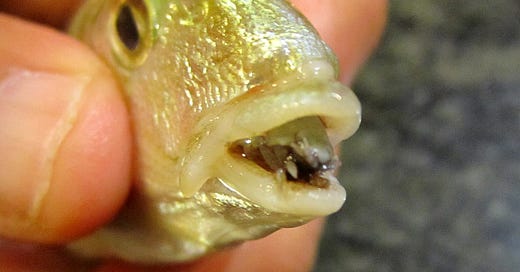Sex, lice and videotape
The isopod suborder Cymothoida consists of about 380 species of parasites with diverse life histories. Found in both marine and freshwater ecosystems, cymothoids are among isopods commonly known as fish lice. Weird is not a strong enough word to describe their biology.
To begin with, at least some are protandrous hermaphrodites. Juveniles develop first into a male. If no females are around, the male may transform into a female and attach itself permanently to a host. It then secretes pheromones preventing any nearby males from also turning into females. Some fish infested by these parasites die; more often, they fail to gain weight at a normal pace and suffer tissue damage of one sort or another. Some fish have a mutualistic relationship with shrimp, the latter feeding on the parasites.
Adult fish lice are host specific, yet juveniles begin life by attaching themselves temporarily to just about any fish passing by. Producing anticoagulants to keep the supply flowing, they feed on the host’s blood. Detaching from one host and reattaching to another, they are transported by fish like uber drivers until they locate an individual of the right host species required to complete their development.
Even among these hundreds of strange species, one stands out as especially and disgustingly bizarre. The so-called tongue-eating louse. I’ve been called worse names, but never a more colorful one. I think I will file this one away for future use. Someday, when an unsuspecting, il-mannered person cuts in front of me at the cinema ticket line, I’ll say “Hold it right there, you tongue-eating louse!” Unfortunately for infected fishes, the name is only slightly hyperbolic. They do not literally eat the host’s tongue, but they may as well do. Tongue-biters, as they are sometimes called, are found in no less than eight genera of Cymothoida, so attaching themselves inside the mouth of a fish isn’t even the unusual part of their story. Lodging themselves in the fish’s mouth, they use their claws to sever blood vessels. The tongue then becomes necrotic and degenerates. Wait, it gets worse. The louse, attaching itself to the muscles of the remaining stub and mouth floor to become a functional replacement for the tongue! Not only does the host survive and the parasite resemble its tongue, the fish continues to feed normally, more or less — although with some indication of a bit of reduction in the rate of growth.
This fish, having had its tongue replaced by the isopod parasite Cymothoa exigua, isn’t talking. Photo: Marco Vinci. CC BY-SA 3.0.
To be precise, it is a female which enters the fish through the gills before attaching to the tongue. Males attach to the gill arches, thus locating themselves beneath or behind the female. Females are at most about an inch in length, males about half their size.
This monstrous louse, Cymothoa exigua, is distributed from the Gulf of California southward to the Gulf of Guayaquil, Ecuador, at depths of six to two hundred feet. Among its documented hosts are certain snappers and drums and at least one species of grunt and grunion. There is conflicting evidence about just how long this buccal habitation continues; one story has the female producing a single brood of several hundred eggs, another suggests that they produce multiple broods and may persist as erstwhile tongues for up to three years.
Fortunately, these little terrors can only harm us in the wallet. They do not attack or injure people in any way, but can affect fish health and thereby impact commercial fisheries. There was once a dismissed lawsuit in Puerto Rico brought by someone who claimed to have been poisoned by eating a snapper which had a louse for a tongue. Unappetizing as that may have been, the lice like other isopods are not poisonous.
In 2012, there was a mockumentary film called The Bay about an outbreak of parasites behaving in a way inspired by this fish louse; I watched the trailer, but did not subject myself to the film. At the Natural History Museum in London in 2017 photographs of the parasite in the mouth of its host were shortlisted in the photographer of the year competition. And in 2022, in the horror game How Fish is Made, an isopod uses a fish as a mouthpiece.
New species of cymothoids continue to be discovered and the life histories of most species remain largely unstudied. There is no doubt other bizarre stories wait to be told, but we’ll have to tell them because fish, at least the lucky ones, will continue to hold their tongues.
Further Reading
Bates, Mary (2012). Tongue-eating parasites inspire new horror movie. AAAS. https://www.aaas.org/tongue-eating-parasites-inspire-new-horror-movie
Brusca, R. C. and Gilligan, M. R. (1983) Tongue replacement in a marine fish (Lutjanus guttatus) by a parasitic isopod (Crustacea: Isopoda). Copeia 1983: 813-816.
Chappell, Bill (2021) The tongue-eating louse does exactly what its name suggests. NPR. https://www.npr.org/2021/10/23/1048718433/the-tongue-eating-louse-does-exactly-what-its-name-suggests
Martin, Melissa (2014) Fish tongue biters: more than just one of a kind. Australian Mueum Blog. https://australian.museum/blog-archive/science/amri-fish-tongue-biters-more-than-just-one-of-a-kind/




